- Home
- Quizzes
- My Quiz Activity
- Newsletters
- Sports Betting
- MY FAVORITES
- Add Sports/Teams
- SPORTS
-
NFL
- NFL Home
- Arizona Cardinals
- Atlanta Falcons
- Baltimore Ravens
- Buffalo Bills
- Carolina Panthers
- Chicago Bears
- Cincinnati Bengals
- Cleveland Browns
- Dallas Cowboys
- Denver Broncos
- Detroit Lions
- Green Bay Packers
- Houston Texans
- Indianapolis Colts
- Jacksonville Jaguars
- Kansas City Chiefs
- Las Vegas Raiders
- Los Angeles Chargers
- Los Angeles Rams
- Miami Dolphins
- Minnesota Vikings
- New England Patriots
- New Orleans Saints
- New York Jets
- New York Giants
- Philadelphia Eagles
- Pittsburgh Steelers
- San Francisco 49ers
- Seattle Seahawks
- Tampa Bay Buccaneers
- Tennessee Titans
- Washington Commanders
-
MLB
- MLB Home
- Arizona Diamondbacks
- Atlanta Braves
- Baltimore Orioles
- Boston Red Sox
- Chicago White Sox
- Chicago Cubs
- Cincinnati Reds
- Cleveland Guardians
- Colorado Rockies
- Detroit Tigers
- Houston Astros
- Kansas City Royals
- Los Angeles Angels
- Los Angeles Dodgers
- Miami Marlins
- Milwaukee Brewers
- Minnesota Twins
- New York Yankees
- New York Mets
- Oakland Athletics
- Philadelphia Phillies
- Pittsburgh Pirates
- San Diego Padres
- San Francisco Giants
- Seattle Mariners
- St. Louis Cardinals
- Tampa Bay Rays
- Texas Rangers
- Toronto Blue Jays
- Washington Nationals
-
NBA
- NBA Home
- Atlanta Hawks
- Boston Celtics
- Brooklyn Nets
- Charlotte Hornets
- Chicago Bulls
- Cleveland Cavaliers
- Dallas Mavericks
- Denver Nuggets
- Detroit Pistons
- Golden State Warriors
- Houston Rockets
- Indiana Pacers
- Los Angeles Clippers
- Los Angeles Lakers
- Memphis Grizzlies
- Miami Heat
- Milwaukee Bucks
- Minnesota Timberwolves
- New Orleans Pelicans
- New York Knicks
- Oklahoma City Thunder
- Orlando Magic
- Philadelphia 76ers
- Phoenix Suns
- Portland Trail Blazers
- Sacramento Kings
- San Antonio Spurs
- Toronto Raptors
- Utah Jazz
- Washington Wizards
-
NHL
- NHL Home
- Anaheim Ducks
- Arizona Coyotes
- Boston Bruins
- Buffalo Sabres
- Calgary Flames
- Carolina Hurricanes
- Chicago Blackhawks
- Colorado Avalanche
- Columbus Blue Jackets
- Dallas Stars
- Detroit Red Wings
- Edmonton Oilers
- Florida Panthers
- Los Angeles Kings
- Minnesota Wild
- Montreal Canadiens
- Nashville Predators
- New Jersey Devils
- New York Islanders
- New York Rangers
- Ottawa Senators
- Philadelphia Flyers
- Pittsburgh Penguins
- San Jose Sharks
- Seattle Kraken
- St. Louis Blues
- Tampa Bay Lightning
- Toronto Maple Leafs
- Vancouver Canucks
- Vegas Golden Knights
- Washington Capitals
- Winnipeg Jets
- NCAAF
- NCAAM
- Boxing
- Entertainment
- Lifestyle
- Golf
- MMA
- Soccer
- Tennis
- Wrestling
- More Sports
- RESOURCES
- My Account
- YB on Facebook
- YB on Twitter
- YB on Flipboard
- Contact Us
- Privacy Policy
- Terms of Service
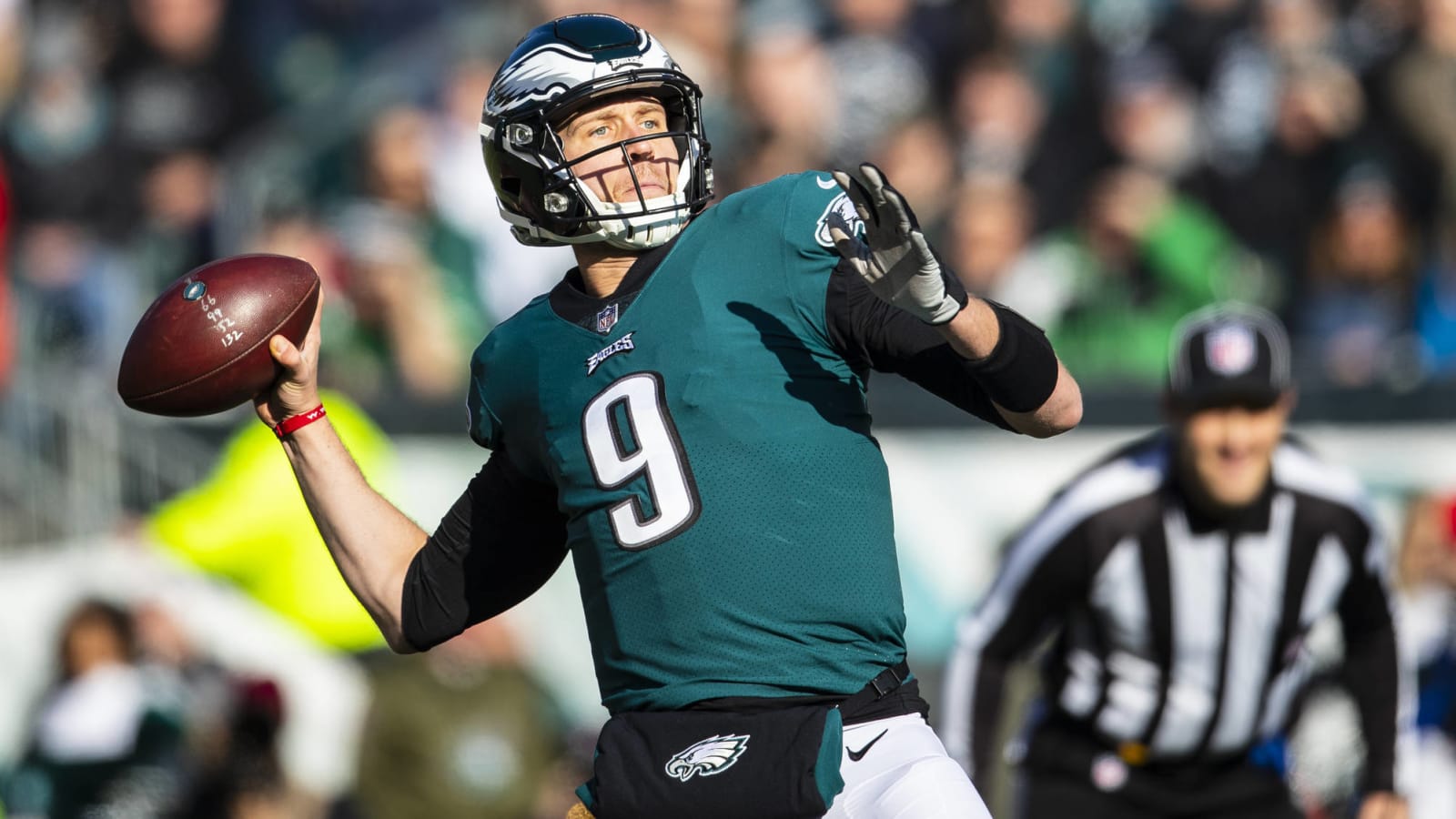
The best reunions in NFL history
A few players joined former employers this offseason. Both Trent Brown and Kyle Van Noy are back in New England. While Bill Belichick has used this strategy effectively, other teams have as well. Here are the best reunion efforts since the 1970 AFL-NFL merger.
25. Tony Martin, Miami Dolphins
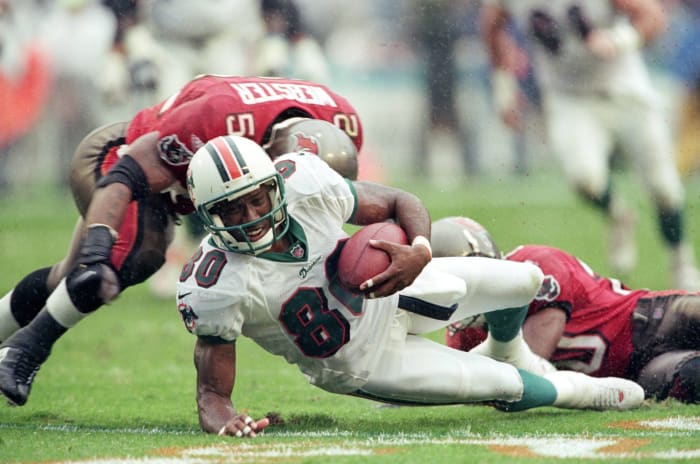
Mostly a backup behind the Marks Brothers in his early-1990s Miami tenure, Martin made a bigger impact in San Diego and Atlanta. He started for two Super Bowl-qualifying teams and made a Pro Bowl as a Charger. The Dolphins brought Martin back in 1999, and Dan Marino's former auxiliary target led the way in the legend's final season. Martin paced the Dolphins with 1,037 receiving yards, helping Miami back to the playoffs during a year in which a declining Marino missed five games. Foot trouble nagged Martin in 2000, but he became the rare skill-position player to impact a team more in his mid-30s than his mid-20s.
24. Moe Williams, Minnesota Vikings
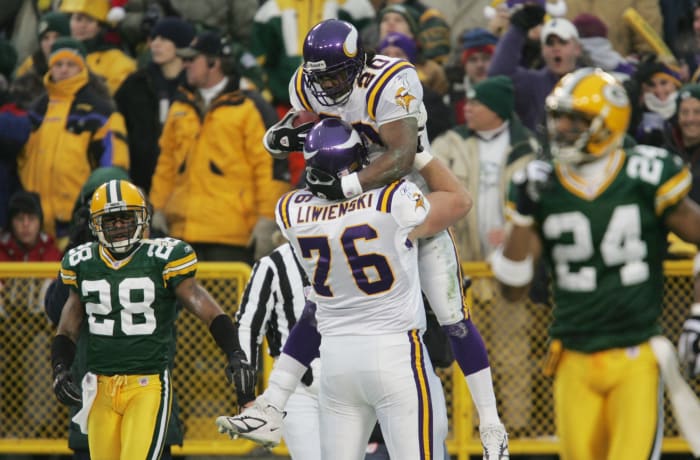
Williams' career featured scant usage on offense until his sixth season. The 1996 third-round pick worked mostly as a kick returner in his first five-year tour with the Vikings when he backed up Robert Smith. Williams and Smith departed in 2001, Smith retiring and Williams leaving for Baltimore. But Williams returned in '02 and suddenly became needed. He rushed for 11 TDs in his first season back and amassed 1,389 scrimmage yards in 2003, subbing for injured speedster Michael Bennett. Williams' role lessened in his final two seasons, but he did deliver a 68-yard catch-and-run TD in a 2004 playoff win in Green Bay.
23. Ian Gold, Denver Broncos
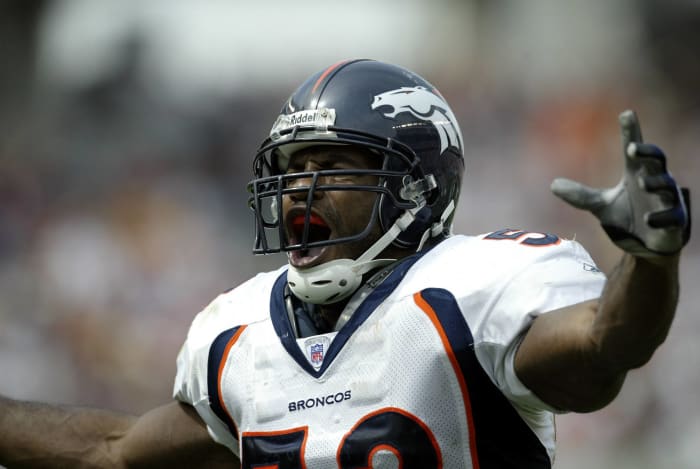
One of a few players Mike Shanahan had success rehiring, Gold made his second Denver stint more memorable than his first. A special-teamer for a chunk of his first Broncos stretch, Gold joined the Buccaneers in free agency in 2004. That deal lasted one year, but Gold rejoined the Broncos soon after. He became an impact player for a 2005 Denver team that went 13-3 behind its No. 3-ranked defense. The undersized outside 'backer made 12 tackles for loss, recorded three sacks, and forced four fumbles in his first season back. Gold started for another top-10 defense in '06; the Broncos cut him in 2008.
22. Fred McAfee, New Orleans Saints
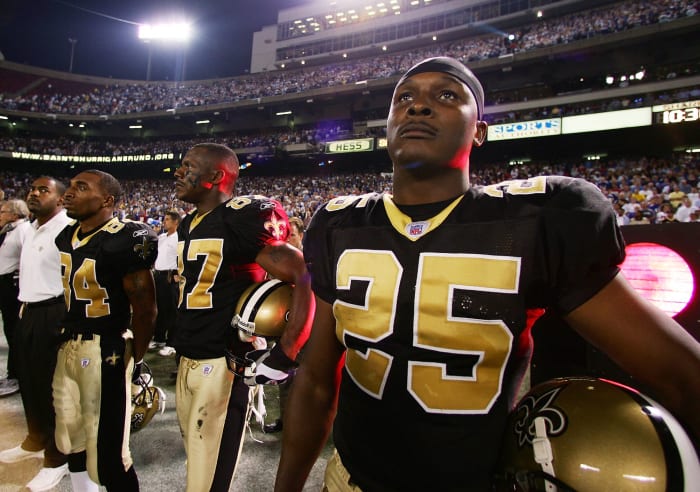
Special-teamers often enjoy lengthy careers, but generally, the kicker-punter-long snapper genre of special-teamer has that privilege. McAfee played 16 seasons as mostly a true special-teamer. A 1991 sixth-round Saints pick, McAfee played running back in his first three Saints slates. But after a nomadic six years to close the '90s, McAfee returned to New Orleans. He spent seven seasons as a special teams leader. McAfee's unusual career arc included a 2002 Pro Bowl, 30 special teams tackles in 2005, and roles on the Saints' kick and punt units until age 38 -- when he unretired and played for Sean Payton's NFC championship-bound team.
21. Julius Peppers, Carolina Panthers
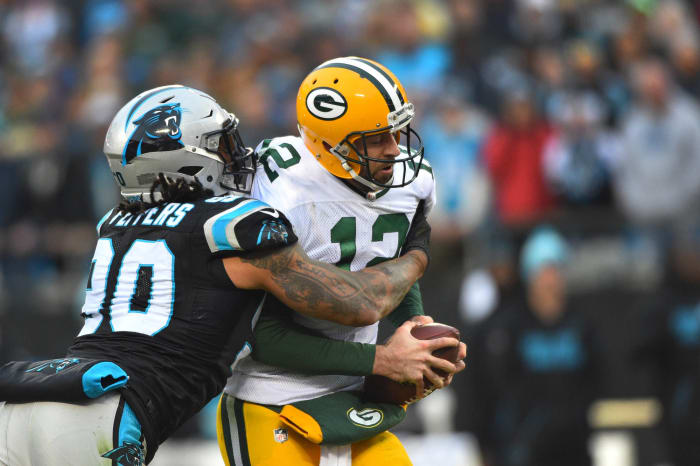
Remaining productive into his late 30s, the NFL's No. 4 all-time sacker finished his career in a familiar place. The Panthers drafted Peppers second overall in 2002 but let him walk in free agency in 2010 when the 6-foot-7 defensive end signed a defender-record contract with the Bears. After spending the ensuing six seasons in Chicago and Green Bay, the North Carolina native came home in 2017. The ex-Tar Heel two-sport standout signed a one-year deal and registered 11 sacks, at age 37, for a playoff-bound Panthers team. Peppers returned in 2018, collecting five more sacks to finish his 17-year career with 159.5.
20. Mark Stepnoski, Dallas Cowboys
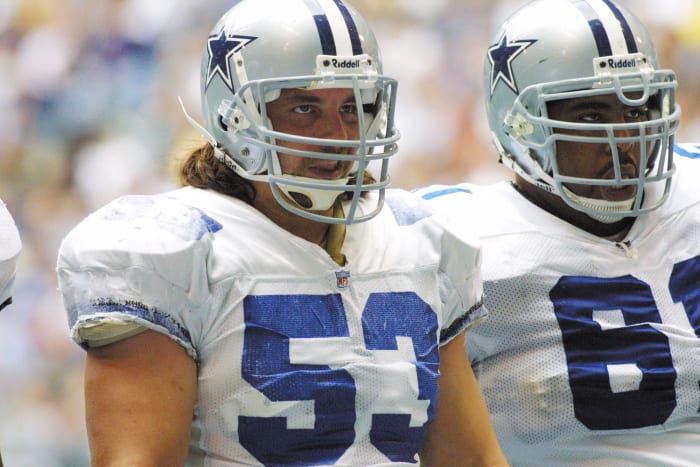
Part of Dallas' historically good offensive line that launched Emmitt Smith to early-'90s superstardom, Stepnoski joined the Oilers for the 1995 season. He stayed with the franchise for four years, following it to Tennessee for two of those, but agreed to return to the Cowboys in 1999. While Smith was past his prime by this point, his initial center's return helped keep Dallas' run game elite. The Cowboys boasted two top-six rushing attacks in Stepnoski's three-year second act, including in a 2001 season that featured Quincy Carter at quarterback. Yes, Larry Allen also helped, but Stepnoski did well back in Dallas.
19. Ron Smith, Chicago Bears
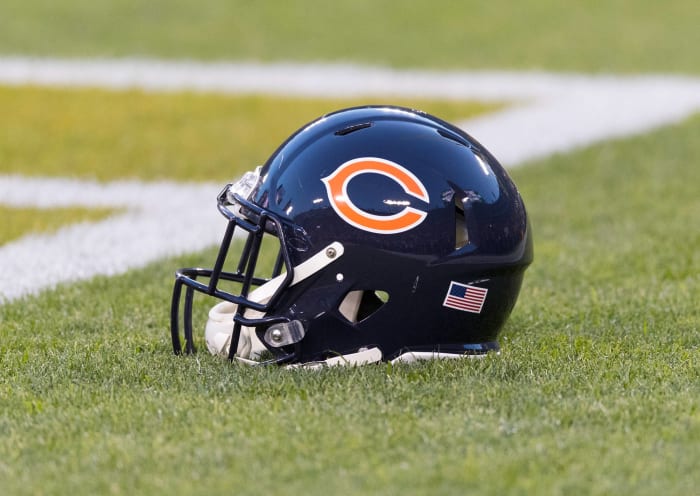
A Chicago native, Smith caught on with his hometown team as a free agent in 1965 but was lost to the Falcons in a 1966 expansion draft. The defensive back closed out the '60s on the Rams, but they traded him back to the Bears in 1970. Smith saw action at corner and was a multi-year safety starter in Chicago. He made the 1972 Pro Bowl as a return man, however, having served as both Chicago's kick and punt returner -- in addition to working as a full-time safety -- in his second stay. The Bears traded Smith to the Chargers in 1973.
18. Larry Csonka, Miami Dolphins
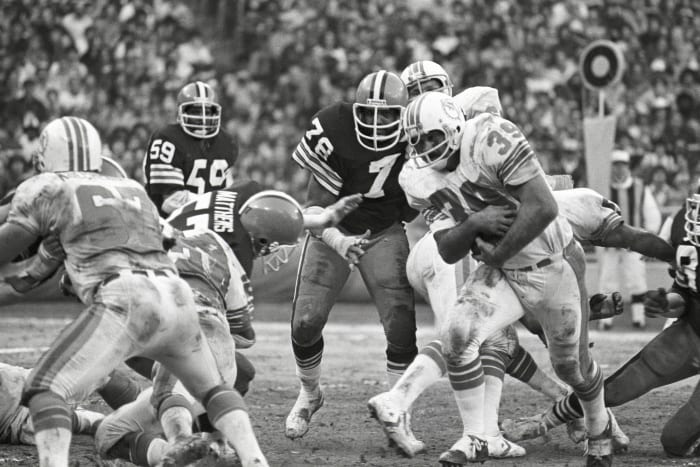
Csonka's first Dolphins stint ended when the deep-pocketed (for a short time) World Football League poached him in 1975. The WFL, which spawned in 1974, folded midway through the '75 season. Sour negotiations between Csonka and Dolphins owner Joe Robbie sent the future Hall of Fame fullback to the Giants, who were mired in a brutal stretch. The Giants released an injury-plagued Csonka in 1979, and he returned to Miami. At 32, Csonka had his best season since his first Miami chapter. He gained 837 rushing yards, rushed for 12 TDs, and played a key role for a division champion. Csonka retired at season's end.
17. Jason Babin, Philadelphia Eagles
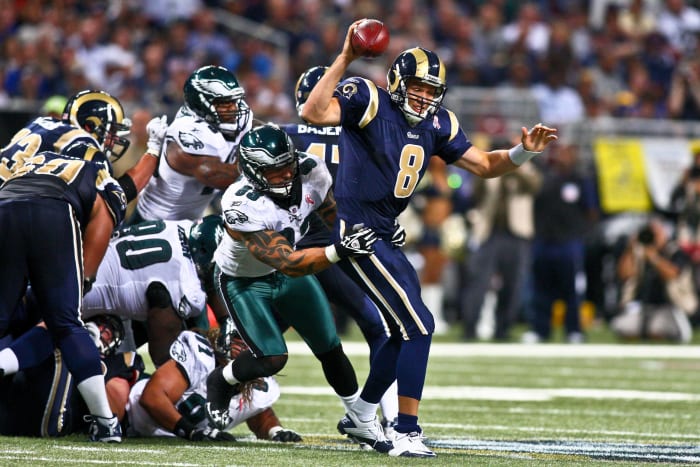
Part of the Eagles' 2011 "Dream Team" effort, Babin returned to Philly after spending the 2010 season in Tennessee. The former first-round defensive end was an Eagle in 2009, but the team refused to match a Titans $1 million offer sheet. The Eagles paid up in 2011, signing Babin for five years and $28M. Babin rampaged to an 18-sack season, proving his breakout Titans year (12.5 sacks) was no fluke. However, the Eagles -- whose 2011 offseason became a warning sign for early anointment -- waived him during the 2012 season. Babin was unable to recapture his 2011 magic henceforth.
16. Shannon Sharpe, Denver Broncos
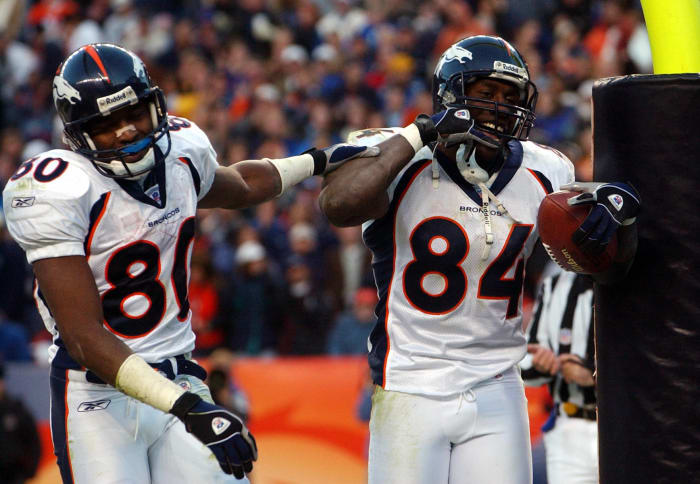
After two productive seasons in Baltimore, Sharpe became a Ravens cap casualty in 2002. The Raiders and Seahawks showed interest, but the future Hall of Famer re-signed with the Broncos -- with whom he played the first 10 seasons of his career. Sharpe aided two Broncos offenses, particularly 2003's Jake Plummer-led attack, and set multiple records in his second Denver tenure. Sharpe's 214-yard outing in Kansas City remains the NFL's single-game tight end yardage mark. During his 770-yard, eight-TD 2003 slate, Sharpe added the career tight end TD mark to his list of then-records and helped the Broncos back to the playoffs.
15. James Harrison, Pittsburgh Steelers
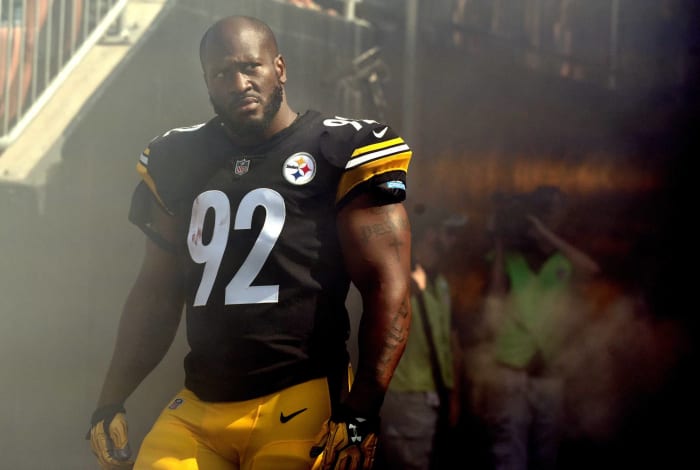
Harrison's one-season stay in Cincinnati did not work out, and the feared edge rusher remained in free agency for five months in 2014. The Steelers re-signed Harrison in September and saw him rediscover some of his first-stint form. A Steeler from 2004-12, the former Defensive Player of the Year recorded 15.5 sacks from 2014-16. He helped a Pittsburgh defense lacking the talent it once possessed and drew an Eric Fisher holding penalty on a two-point conversion to help the Steelers oust the Chiefs in the 2016 divisional round. A playing-time dispute led to the Steelers waiving Harrison in 2017 when he finished his career as a Patriot.
14. Laveranues Coles, New York Jets
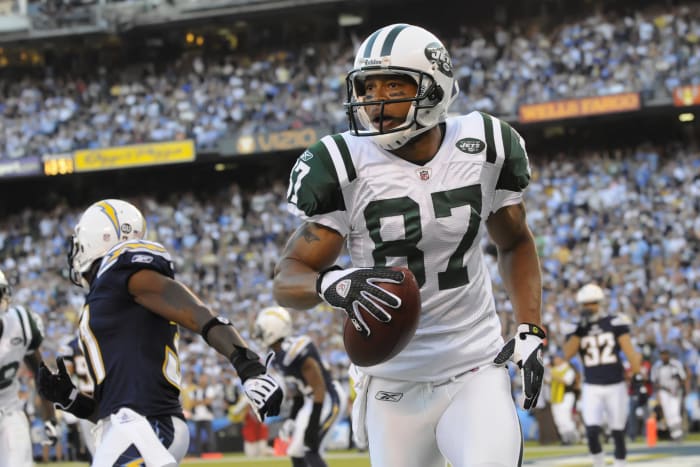
A seven-year, $35 million Washington offer sheet broke up the Jets' Coles-Santana Moss receiving duo, with Washington prying Coles away after a career-best 2002 season. In 2005, however, New York and Washington swapped Moss and Coles in a trade involving only the sub-6-foot wideouts. Moss spent the next 10 seasons in D.C., and while Coles' second Jets stay lasted just four, he remained productive into his 30s. He posted a 1,000-yard season for the playoff Jets team in 2006 and remained Chad Pennington's top target through the '08 season. Coles still sits in the Jets' top five in all major career receiving categories.
13. Eddie Robinson, Tennessee Titans
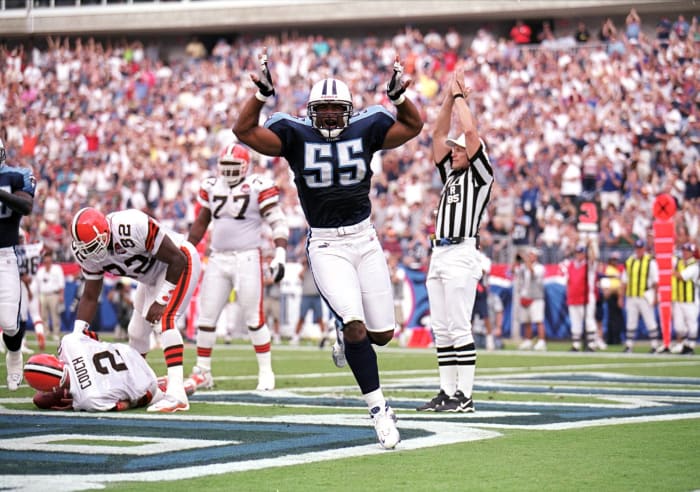
An unusual reunion, but it counts. A 1992 Oilers second-round pick, Robinson left Houston as a free agent in 1996. The linebacker started two seasons for a quick-developing Jaguars team, but after the Jags cut him in 1998, the veteran returned to the franchise that drafted him. It was in Tennessee by this point. A Houston Oiler, Tennessee Oiler, and Tennessee Titan, Robinson did not miss a game in four Tennessee seasons and came up big in the two biggest games in Titans history. Robinson forced two fumbles in the 1999 AFC championship game (a win over the Jags) and Super Bowl XXXIV. He also started for the 2000 team's elite defense.
12. Keith Traylor, Denver Broncos
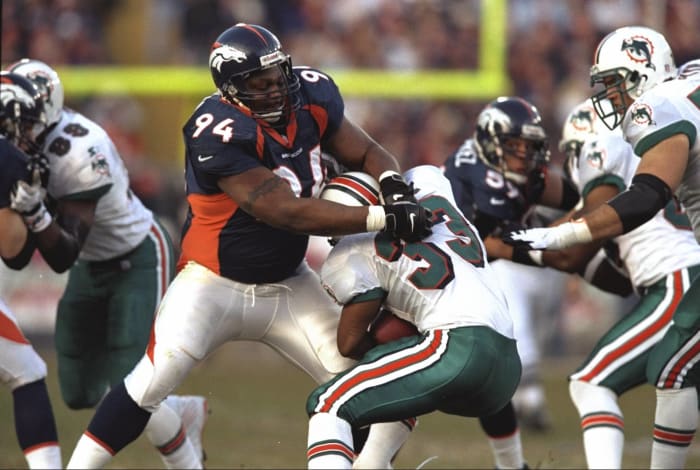
Traylor's James Toney-like metamorphosis goes overlooked, but this reunion featured a much different player coming back to Denver. The Broncos drafted Traylor as a linebacker in 1991 but kept him for just two years. When Traylor returned to Colorado in 1997, he was several weight classes north of his early-'90s stature. A defensive tackle in his second Broncos run, Traylor became essential for a team that won back-to-back Super Bowls. His 62-yard INT return in Buffalo helped Denver escape with a 1997 OT win, and the 300-plus-pounder remained a Broncos starter through 2000. The weight gain helped keep Traylor in the NFL until 2007.
11. Charles Woodson, Oakland Raiders
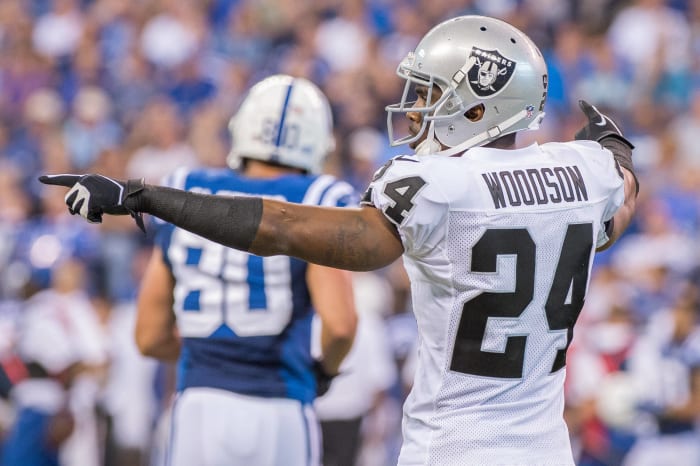
Not that his Hall of Fame credentials needed burnishing, but the 2021 inductee padded his resume with three seasons back in Oakland. Returning to the Raiders in 2013, after seven Packers seasons, Woodson did so as a safety. A lockdown cornerback in his first Raiders tour, Woodson was the biggest name on some bad Raiders teams. He added 10 INTs, including five in his age-39 2015 farewell season, to wrap his career with 65 (tied for fifth all-time). This did not result in a Raiders playoff berth or particularly imposing defenses, but Woodson did not miss a game and ended an 18-year career on a high note.
10. Richie Incognito, Buffalo Bills
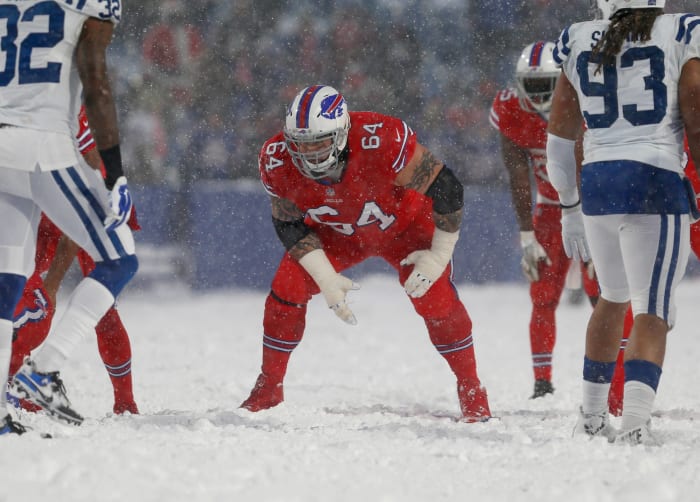
Incognito's first Bills cameo came at the end of the 2009 season when the team claimed him off waivers after the Rams grew tired of the talented guard's antics. Incognito's second Buffalo arrival came after his career-defining Bullygate scandal, which led to the polarizing blocker missing the 2014 season. The Bills gave Incognito another chance in 2015, signing him for one year and $2.25 million. He made the next three Pro Bowls and opened lanes for LeSean McCoy on two No. 1-ranked rushing attacks. The Bills cut Incognito in 2018 when more off-field trouble led to him missing a full season.
9. Otis Smith, New England Patriots
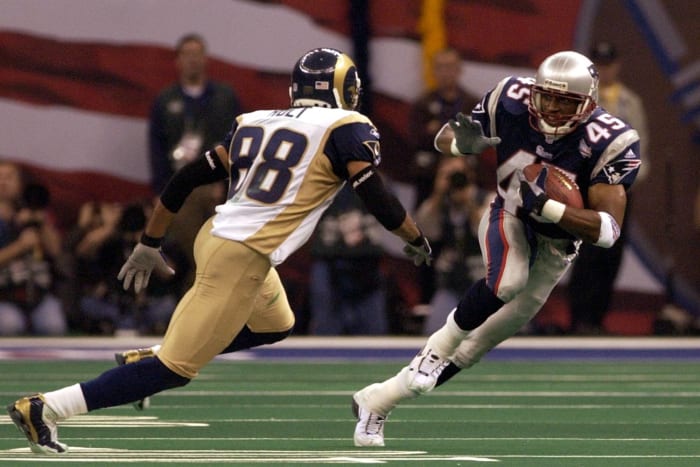
Smith is the rare player to reunite with two teams. The Eagles UDFA caught on with Rich Kotite again with the Jets. However, they cut the cornerback early in the 1996 season. Smith proceeded to play under Bill Belichick for the next six years. He landed with the Pats' '96 Super Bowl team, followed Belichick and Bill Parcells to the Jets in '97, and accompanied Belichick to New England in 2000. Despite being 36, Smith delivered in 2001. He returned two of his five INTs back for touchdowns and added a pick of Kurt Warner in the Pats' Super Bowl XXXVI upset. Smith was a three-year Pats starter, keeping that gig at 37 in 2002.
8. Kevin Greene, Carolina Panthers
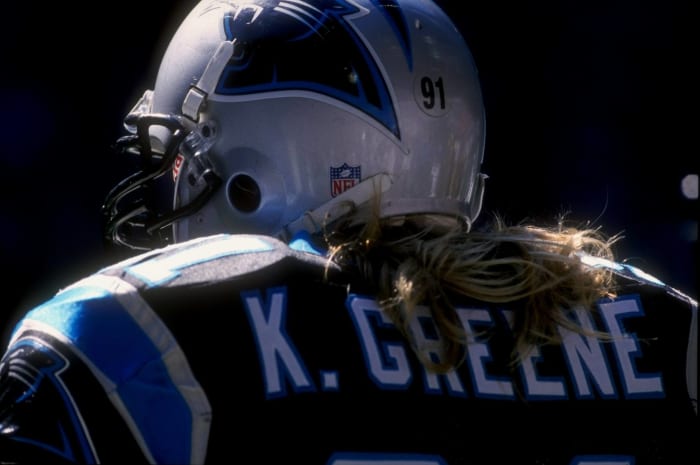
Although the Panthers made Greene part of their defense-powered 1996 emergence, they cut the all-time great just ahead of the 1997 season. The 49ers also used the energetic edge rusher as a one-and-done, releasing him shortly after the '97 slate. Greene returned to Carolina in 1998 and did what he always did: drop quarterbacks. At 36, Greene registered 15 sacks for the '98 Panthers and made his final Pro Bowl. He returned for one final season and posted 12 sacks, giving him 160 for his career. That ranks third all-time. Given how long it took the Hall of Fame to enshrine Greene, his second Panthers stay loomed large.
7. Tyrone Braxton, Denver Broncos
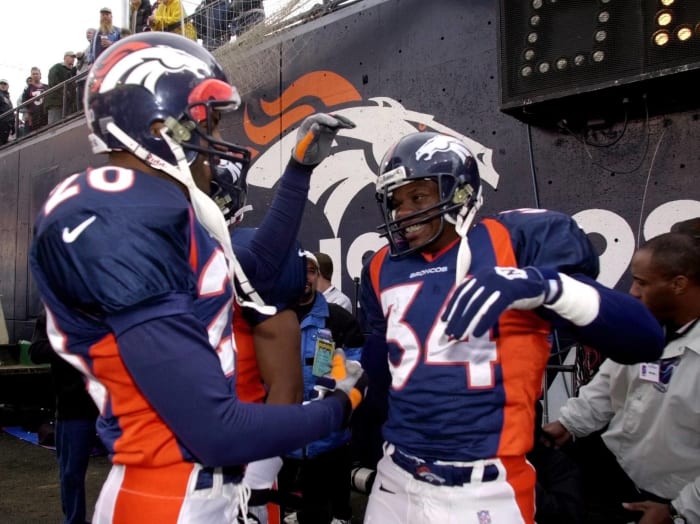
John Elway was not alone among the Broncos who suited up for Super Bowl XXII and XXXII. Braxton, a rookie in 1987, joined the QB icon. He held a bigger role 10 years later. A cornerback in his first Broncos tour, Braxton joined the Dolphins in 1994. He returned to the Broncos a year later as a safety, replacing the retired Dennis Smith alongside Steve Atwater. The middle-bar facemask loyalist started the next five years. Braxton's NFL-high nine INTs helped the 1996 Broncos to the No. 1 seed. He added six more in '97 -- including one that set up an Elway TD in Super Bowl XXXII -- and recovered two fumbles in Denver's 1998 playoff run.
6. LeGarrette Blount, New England Patriots

The Steelers' two-year, $3.85 million Blount deal mattered little, with the power back's Pittsburgh tenure remembered because he left the field before the end of a 2014 game. The Steelers promptly waived Blount that November. Two days later, he resurfaced in New England. Blount, who rushed for four TDs in a Patriots divisional-round rout of the Colts earlier that year, regained form with the Pats. He dominated the Colts again in the Deflategate AFC title game and collected two more rings -- the second coming after an NFL-best 18 rushing TDs in 2016. Blount added ring No. 3 by helping the Eagles beat the Pats in Super Bowl LII.
5. Jeremiah Trotter, Philadelphia Eagles
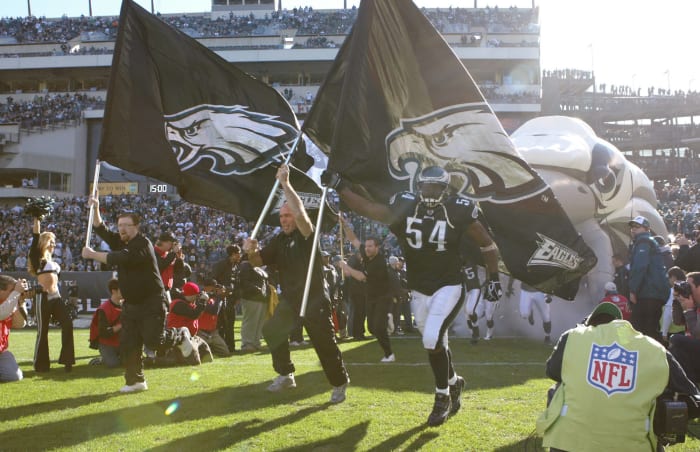
Although the Eagles were unable to keep Trotter as a free agent in 2002, when he defected to Washington on a seven-year deal worth $35.5 million, he ended up coming back twice. Washington released Trotter after two seasons, and he revived his career back in Philly in 2004. Reinstalled as the Eagles' starting middle linebacker midway through the '04 slate, Trotter lifted a struggling run defense and helped the Eagles to Super Bowl XXXIX. He combined for 23 tackles for loss between the 2004-05 seasons, making two Pro Bowls. Trotter's second Eagles stay ended after 2006, but he ended his career on the playoff-bound '09 team.
4. Patrick Chung, New England Patriots
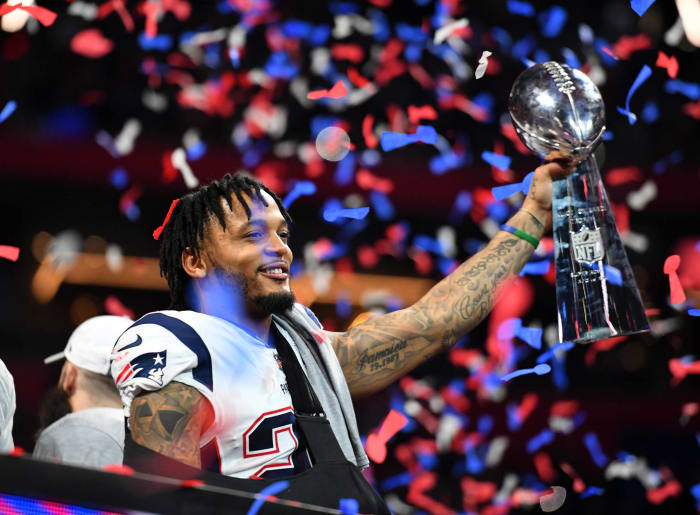
Few players have Chung beat for Super Bowl snaps. The veteran safety played in five Super Bowls; four of those came in his second Patriots tour. Chung lasted one season with the Eagles (2013), returning to New England after being cut. Belichick used him as a starter for the next six seasons; four of those ended in Super Bowls. Chung signed four more Pats contracts and started for three more championship teams, playing an integral part on perennial top-10 defenses. Devin McCourty's back-line wingman, who retired this year, will be entrenched near the top of certain Super Bowl lists for a while.
3. Nick Foles, Philadelphia Eagles
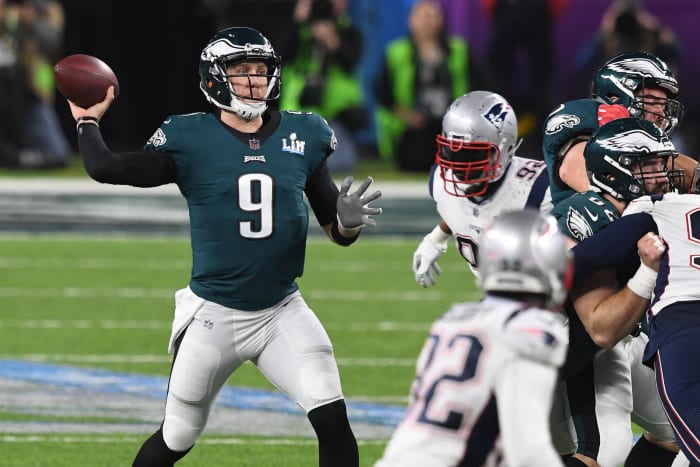
Foles maximized his time as Eagles QB1. During a maligned year in power, Chip Kelly traded his starting QB for Sam Bradford in 2015. The former Eagles Round 2 pick returned on a two-year, $11M deal in 2017. This became a prudent investment, with Carson Wentz's run of injuries beginning that December. After a shaky start, Foles delivered two all-time playoff outings. His 352-yard, three-TD showing in the NFC title game goes understandably overlooked, as the backup's Super Bowl start will live on forever. Foles saved the 2018 Eagles' season as well, guiding them from 6-7 to the divisional round. He has not approached this level elsewhere.
2. Harold Jackson, Los Angeles Rams
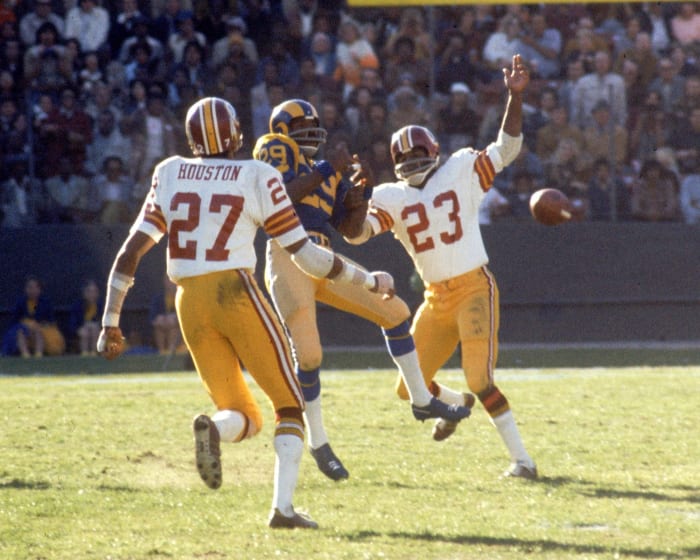
Blazing the trail Brandin Cooks traveled, Jackson was thrice traded. But the diminutive speedster was one of his era's best receivers, retiring second in all-time aerial yardage. A 12th-round Rams pick in 1968, Jackson joined the Eagles via 1969 trade. But 1973's monster Roman Gabriel trade broke up Philly's Jackson-Harold Carmichael pair, sending Jackson back to L.A. He stayed in top form, making three Pro Bowls with the Rams from 1973-77. Jackson lacked the QB stability of his elite wideout peers but produced anyway, scoring four playoff TDs in his second Rams run. The Rams traded him to the Patriots in 1978.
1. Fran Tarkenton, Minnesota Vikings
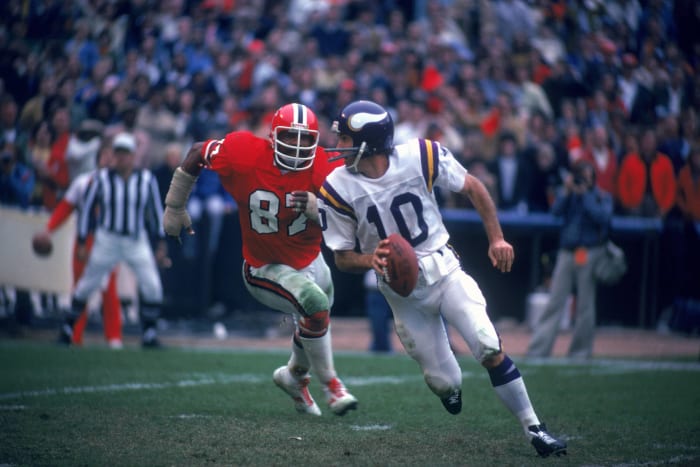
A runaway No. 1, Tarkenton led the Vikings to three Super Bowls and retired miles ahead on all-time passing lists. Clashes with Vikings coach Norm Van Brocklin led to a Tarkenton trade to the Giants in 1967. By the time the Bud Grant-run Vikes reacquired him in 1972, they had assembled a roster filled with Hall of Famers. The dual-threat QB stabilized a wayward Minnesota passing situation and drove the team to three Super Bowls and closed his career with six straight NFC Central titles. Tarkenton led the field by 52 TD passes and nearly 7,000 yards when he retired after the 1978 season.
Sam Robinson is a Kansas City, Mo.-based writer who mostly writes about the NFL. He has covered sports for nearly 10 years. Boxing, the Royals and Pandora stations featuring female rock protagonists are some of his go-tos. Occasionally interesting tweets @SRobinson25.
More must-reads:
- The best NFL free-agent signing from every previous offseason
- The top NFL pass-rushing duos of the sack era
- The '100 catches in an NFL season' quiz
Breaking News
Customize Your Newsletter
 +
+
Get the latest news and rumors, customized to your favorite sports and teams. Emailed daily. Always free!
Use of this website (including any and all parts and
components) constitutes your acceptance of these
Terms of Service and Privacy Policy.

